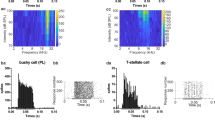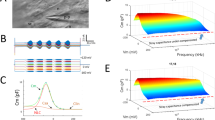Abstract
In the acoustico-lateralis systems of vertebrates the individual hair cells are usually polarised in their responses to displacements of the liquid in which they lie, and are often arranged in back-to-back pairs or groups with different polarities. A simple example to investigate, mechanically as well as electrically, is the utriculus of the sprat (Clupea sprattus L.). The acoustico-lateralis system of the sprat and other clupeids has two partly gas-filled bony bullae which transform pressure changes into liquid displacements capable of stimulating the sense organs of the ear and lateral line1–3. With its related structures the utriculus is a very sensitive sound pressure detector which has one population of receptors that respond to the compressions and another that respond to the decompressions of a sound wave. We now give additional evidence that this type of organisation is unlike that of the mammalian cochlea in being specialised more for the detection of phase/time relationships than for frequency analysis.
This is a preview of subscription content, access via your institution
Access options
Subscribe to this journal
Receive 51 print issues and online access
$199.00 per year
only $3.90 per issue
Buy this article
- Purchase on Springer Link
- Instant access to full article PDF
Prices may be subject to local taxes which are calculated during checkout
Similar content being viewed by others
References
Allen, J. M., Blaxter, J. H. S. & Denton, E. J. J. mar. Biol. Ass. U.K. 56, 471–486 (1976).
Gray, J. A. B. & Denton, E. J. J. mar. Biol. Ass. U.K. 59, 11–26 (1979).
Denton, E. J., Gray, J. A. B. & Blaxter, J. H. S. J. mar. Biol. Ass. U.K. 59, 27–47 (1979).
Popper, A. N. & Platt, C. Nature 280, 832–833 (1979).
O'Connell, C. P. Fishery Bull. Fish Wildl. Serv. U.S. 56, 505–533 (1955).
Zotterman, Y. J. Physiol., Lond. 102, 313–318 (1943).
Jielof, R., Spoor, A. & de Vries, H. J. Physiol., Lond. 116, 137–157 (1952).
Flock, A. Acta oto-lar. Suppl. 199, 1–90 (1965).
Piddington, R. W. J. exp. Biol. 56, 403–419 (1972).
Schuijf, A. in Sound Reception in Fish (eds Schuijf, A. & Hawkins, A. D.) 63–86 (Elsevier, Amsterdam, 1976).
Whitfield, I. C. & Ross, H. F. J. acoust. Soc. Am. 38, 126–131 (1965).
Helmholtz, H. L. F. On the Sensations of Tone as a Physiological Basis for the Theory of Music 2nd edn (Dover Publications, New York, 1954).
Stevens, S. S. & Davis, H. Hearing: its Psychology and Physiology (Wiley, New York, 1938).
Author information
Authors and Affiliations
Rights and permissions
About this article
Cite this article
Denton, E., Gray, J. The analysis of sound by the sprat ear. Nature 282, 406–407 (1979). https://doi.org/10.1038/282406a0
Received:
Accepted:
Issue Date:
DOI: https://doi.org/10.1038/282406a0
This article is cited by
-
Coordinated gas release among the physostomous fish sprat (Sprattus sprattus)
Scientific Reports (2021)
-
Are accessory hearing structures linked to inner ear morphology? Insights from 3D orientation patterns of ciliary bundles in three cichlid species
Frontiers in Zoology (2014)
-
A unique swim bladder-inner ear connection in a teleost fish revealed by a combined high-resolution microtomographic and three-dimensional histological study
BMC Biology (2013)
Comments
By submitting a comment you agree to abide by our Terms and Community Guidelines. If you find something abusive or that does not comply with our terms or guidelines please flag it as inappropriate.



